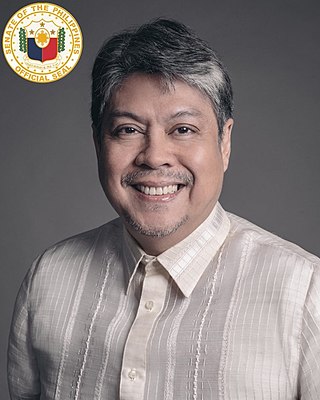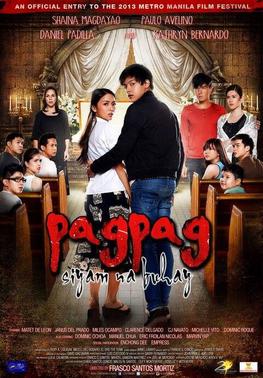
Calabarzon, sometimes referred to as Southern Tagalog and designated as Region IV‑A, is an administrative region in the Philippines. The region comprises five provinces: Batangas, Cavite, Laguna, Quezon, and Rizal; and one highly urbanized city, Lucena. It is the most populous region in the Philippines according to the Philippine Statistics Authority (PSA), having over 16.1 million inhabitants in 2020, and is also the country's second most densely populated after the National Capital Region. It is situated southeast of Metro Manila, and is bordered by Manila Bay and South China Sea to the west, Lamon Bay and the Bicol Region to the east, Tayabas Bay and the Sibuyan Sea to the south, and Central Luzon to the north. It is home to places like Mount Makiling near Los Baños, Laguna, and Taal Volcano in Batangas.

Quirino, officially the Province of Quirino, is a landlocked province in the Philippines located in the Cagayan Valley region in Luzon. Its capital is Cabarroguis. It is named after Elpidio Quirino, the sixth President of the Philippines.

Central Luzon, designated as Region III, is an administrative region in the Philippines, primarily serving to organize the 7 provinces of the vast central plains of the island of Luzon, for administrative convenience. The region contains the largest plain in the country and produces most of the country's rice supply, earning itself the nickname "Rice Granary of the Philippines". Its provinces are: Aurora, Bataan, Bulacan, Nueva Ecija, Pampanga, Tarlac and Zambales. Pangasinan was formerly a province of Central Luzon before President Marcos signed Presidential Decree No. 1, 1972, incorporating it into Ilocos Region. Additionally, the province of Aurora was part of the defunct political region Southern Tagalog when the region was divided into Calabarzon and Mimaropa, upon the issuance of Executive Order No. 103, dated May 17, 2002, by then-President Gloria Macapagal Arroyo, which transferred Aurora to Central Luzon.
Aksyon Demokratiko or simply Aksyon is a political party in the Philippines founded by Raul Roco. It was recognized as a national political party in 1998 by the Commission on Elections (COMELEC) and is considered to be one of the major parties in the Philippines. Former Manila Mayor Isko Moreno currently acts as president of the party.

Filipino cuisine is composed of the cuisines of more than a hundred distinct ethnolinguistic groups found throughout the Philippine archipelago. A majority of mainstream Filipino dishes that compose Filipino cuisine are from the food traditions of various ethnolinguistic groups and tribes of the archipelago, including the Ilocano, Pangasinan, Kapampangan, Tagalog, Bicolano, Visayan, Chavacano, and Maranao ethnolinguistic groups. The dishes associated with these groups evolved over the centuries from a largely indigenous base shared with maritime Southeast Asia with varied influences from Chinese, Spanish, and American cuisines, in line with the major waves of influence that had enriched the cultures of the archipelago, and adapted using indigenous ingredients to meet local preferences.

Divisoria is a commercial center in the districts of Tondo, Binondo, and San Nicolas in Manila, Philippines known for its shops that sell low-priced goods and its diverse manufacturing activities. Tutuban Center is situated within the commercial hub along with a night market located in the Centers' vicinity. The area is riddled with different bazaars, bargain malls, and a few points of interest.

Francis Pancratius "Kiko" Nepomuceno Pangilinan is a Filipino lawyer, politician, and farm owner who served as a Senator from 2001 to 2013 and from 2016 to 2022. He was the Senate Majority Leader from 2004 to 2008.

Ralph Gonzalez Recto is a Filipino politician currently serving as the 33rd Secretary of Finance under President Bongbong Marcos since January 12, 2024. He previously served as the representative for Batangas' 6th district and as the House Deputy Speaker from 2022 to 2024.
Imperial Manila is a pejorative epithet used by sectors of Filipino society and non-Manileños to express the idea that all the affairs of the Philippines, whether in politics, economy and business or culture, are decided by what goes on in the capital region, Metro Manila, without considering the needs of the rest of the country, largely because of centralized government and urbanite snobbery. Empirical research finds that Imperial Manila and its persistence over time has led to prolonged underdevelopment in Philippine provinces.

Batchoy, alternatively spelled batsoy, is a Filipino noodle soup of pork offal, crushed pork cracklings, chicken stock, beef loin, and round noodles. The original and most popular variant, the La Paz batchoy, traces its roots to the Iloilo City district of La Paz, in the Philippines.

Ivan Anthony Dorschner is a Filipino-American actor, television host and model based in the Philippines. He is best known for being a former housemate of the Philippine reality television show Pinoy Big Brother: Teen Clash 2010. He is currently under contract to GMA Network, as well as the network's talent management arm GMA Artist Center along with Mika Dela Cruz and Addy Raj.

In 2021, official government statistics reported that the Philippines had a poverty rate of 18.1%,, significantly lower than the 49.2 percent recorded in 1985 through years of government poverty reduction efforts. From 2018 to 2021, an estimated 2.3 million Filipinos fell into poverty amid the economic recession caused by the COVID-19 pandemic.

Pagpag: Siyam na Buhay is a 2013 Filipino supernatural horror film directed by Frasco S. Mortiz. The film was released on December 25, 2013, at the Metro Manila Film Festival and stars Kathryn Bernardo and Daniel Padilla with Paulo Avelino and Shaina Magdayao. The film follows a group of teenagers that are terrorized by an evil spirit after they do not follow the Filipino paranormal superstitions called "pagpag".

Nicomaine Dei Capili Mendoza-Atayde is a Filipina actress and television personality. She is best known for her viral Dubsmash videos and her role as Yaya Dub in the noontime reality show Eat Bulaga! segment "Kalyeserye", previously aired on GMA Network and worldwide via GMA Pinoy TV. Her rise to fame is often described as phenomenal and unconventional due to the unscripted forming of AlDub love team in Eat Bulaga! on July 16, 2015, where she was paired with Alden Richards. AlDub is a portmanteau of Richards' first name and Mendoza's character in "Kalyeserye".

Pancit Molo or Filipino pork dumpling soup, is a type of soup using wonton wrappers which originated from Molo district in Iloilo City, Philippines. It consists of a mixture of ground pork wrapped in molo or wonton wrapper, shredded chicken meat, and also shrimp. The piping-hot soup is often ladled into serving bowls, and garnished with green onions and fried garlic bits for another layer of flavor. Pancit, which loosely translates to "noodle" is a common cuisine in the Philippines. The "noodle" acting in this dish comes from the wonton wrappers added to this dish, which draws from Chinese cuisine. Under this influence, the wontons within the soup have been compared to "siomai dumplings."

Protests against Former President Rodrigo Duterte escalated on November 18, 2016, following Duterte's support of the burial of the late president Ferdinand Marcos. These series of protests are mostly conducted by progressive groups and other opposing figures mainly due to the ongoing war on drugs, the declaration of martial law in Mindanao, and employment issues such as contractual terms being applied by companies and inflation which occurred due to the passage of the Tax Reform for Acceleration and Inclusion Law. Other causes of the protests include the government's response to the COVID-19 pandemic in the country, the passage of the Anti-Terrorism Act of 2020, and the shutdown and franchise denial of ABS-CBN.

Partido Federal ng Pilipinas is a national political party in the Philippines. It is chaired by Bongbong Marcos, president of the Philippines who won by a landslide in the 2022 election. During the run-up to the 2022 general election, the UniTeam Alliance was formed by the PFP, Lakas–CMD, HNP, and PMP, with guest candidates from other parties.
Malvar: Tuloy ang Laban is an upcoming Filipino biographical war film directed by Jose "Kaka" Balagtas and written by Ed Samson. It will depict the life of Miguel Malvar, one of the last Filipino generals to surrender in the Philippine–American War. The film will star Manny Pacquiao as the titular General Malvar, with Isko Moreno as Andrés Bonifacio and E.R. Ejercito as Emilio Aguinaldo.

The 2022 presidential campaign of Isko Moreno began on September 22, 2021, when Isko Moreno announced his intention to run for the presidency in the 2022 Philippine presidential election. Isko Moreno has served as the mayor of Manila, the country's capital city, from June 30, 2019 to June 30, 2022.

Batchoy Tagalog, also known simply as batsoy, is a traditional Filipino food originating in the northern Philippines. This soup is made with pork, pork offal, pork blood, noodles, chili leaves or garlic chives, green chilies, garlic, onions, and ginger. It is also referred to as sutsa or syutsa in the province of Quezon and sinuam in Angono, Rizal. This dish is usually paired with or eaten with cooked rice as a viand.


















